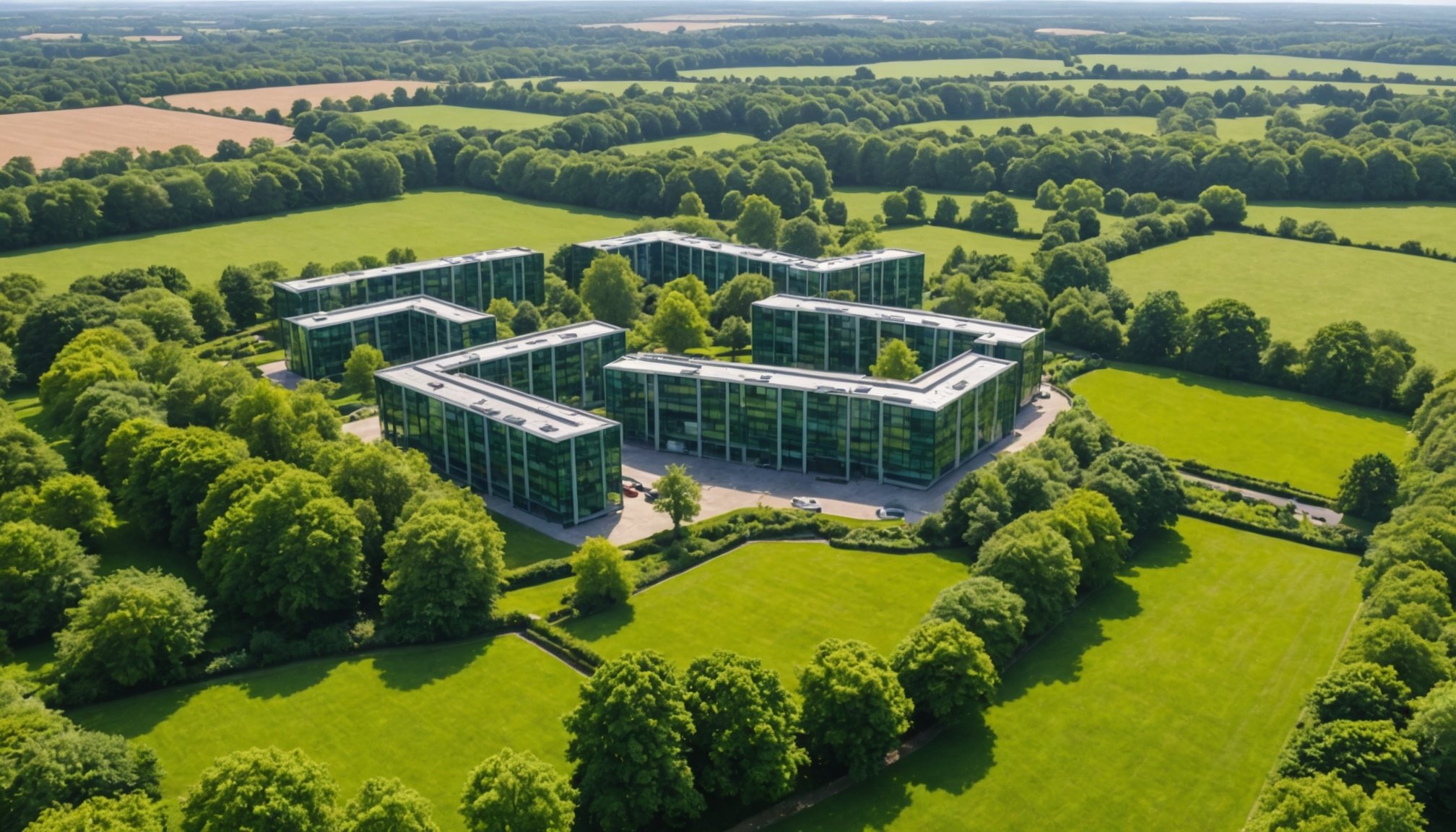Unveiling the Influence of Green Bonds on Sustainable Real Estate Funding in the UK to Green Bonds and Sustainable Real Estate
Green bonds have emerged as a pivotal financial instrument in the quest for sustainable development, particularly in the real estate sector. These bonds are specifically designed to finance projects that have a positive environmental impact, such as green buildings, renewable energy, and energy efficiency initiatives. In the UK, the use of green bonds is gaining momentum, transforming the way real estate projects are funded and managed.
What are Green Bonds?
Green bonds are a type of bond where the proceeds are used exclusively for financing or refinancing green projects. These projects can range from renewable energy installations and energy-efficient buildings to sustainable waste management and clean transportation. Unlike conventional bonds, green bonds are subject to strict criteria and reporting requirements to ensure that the funds are used for their intended environmental purposes.
Have you seen this : Unlocking Profit: The Ultimate Real Estate Investor’s Guide to Leveraging Tax Incentives for Sustainable Success
For instance, HSBC’s Green Bond Framework outlines a rigorous process where projects must be evaluated and approved by the Green Technical Steering Committee (GTSC) to ensure they align with HSBC’s sustainability policies and the United Nations’ Sustainable Development Goals (SDGs)[1].
Impact on the Real Estate Market
The real estate sector is one of the primary beneficiaries of green bond financing. In the UK, this financing mechanism is driving a shift towards more sustainable and energy-efficient estate projects.
Topic to read : Revamping Victorian Homes: Cutting-Edge Eco-Friendly Renovation Techniques for Sustainable Restorations
Green Buildings and Energy Efficiency
Green bonds are being used to finance the development of green buildings, which are designed to reduce environmental impact through energy efficiency and sustainable materials. For example, GuocoLand, a real estate developer, secured nearly $1 billion in green loans to refinance projects like Guoco Midtown and Midtown Bay, which are aligned with their green finance framework and support both environmental and social benefits[2].
### Key Statistics on Green Bond Allocation in Real Estate
- **Green Buildings:** 67% of allocated funds (as of June 2024)[1]
- **Energy Efficiency:** 30% of allocated funds (as of June 2024)[1]
- **Renewable Energy:** 55% of allocated funds (as of June 2024)[1]
- **Sustainable Waste Management:** 1% of allocated funds (as of June 2024)[1]
Market Growth and Investor Interest
The green bond market is experiencing significant growth, attracting a wide range of investors who are increasingly focused on sustainability. In the UK, this growth is driven by both regulatory pressures and market demand. For instance, the FTSE EPRA Nareit Green Index Series measures the performance of real estate equities based on their climate and sustainability metrics, providing investors with a clear benchmark for sustainable investments[3].
Financial Instruments and Mechanisms
Green bonds are part of a broader suite of financial instruments designed to support sustainable finance. Here are some key mechanisms and instruments:
Green Bond Issuance
The process of issuing green bonds involves several steps, including the identification of eligible projects, the evaluation and approval by a technical committee, and the allocation of proceeds to these projects. HSBC, for example, maintains a Green Asset Register to track and ensure that all projects meet the necessary sustainability criteria[1].
Green Loans and Financing
In addition to green bonds, green loans are another financial instrument gaining traction. These loans are designed to support projects that deliver environmental and social benefits. GuocoLand’s recent green loan of nearly $1 billion is a prime example of how these loans can be used to refinance and support sustainable real estate developments[2].
Practical Insights and Actionable Advice
For investors, developers, and financial institutions looking to engage with green bonds, here are some practical insights:
Conduct Thorough Research
Before investing in green bonds, it is crucial to conduct thorough research on the issuer, the projects being financed, and the reporting mechanisms in place. This ensures that the investment aligns with your sustainability goals and risk tolerance.
Diversify Your Portfolio
Diversifying your portfolio to include green bonds can help mitigate risk and enhance long-term returns. Abrdn, for instance, manages a significant portfolio of sustainable funds, highlighting the importance of integrating ESG factors into investment strategies[5].
Engage with Regulatory Frameworks
Understanding and complying with regulatory frameworks such as the Sustainable Finance Disclosure Regulation (SFDR) is essential. These regulations ensure transparency and accountability in sustainable finance practices.
Case Studies and Examples
HSBC’s Green Bond Initiatives
HSBC has been at the forefront of green bond issuance, with a robust framework that ensures the proceeds are used for eligible green projects. For example, their green bond allocations have supported projects in renewable energy, energy efficiency, and sustainable waste management across various regions, including the UK, Hong Kong, and India[1].
GuocoLand’s Green Loan
GuocoLand’s recent green loan of nearly $1 billion is a significant example of how green financing can support large-scale sustainable real estate developments. This loan will refinance projects like Guoco Midtown and Midtown Bay, aligning with GuocoLand’s green finance framework and reinforcing their commitment to sustainable development[2]. and Future Outlook
Green bonds are revolutionizing the way sustainable real estate projects are funded in the UK. With their strict criteria and transparent reporting, these bonds offer a compelling option for investors seeking to make a positive environmental impact.
As the market continues to grow, it is essential for stakeholders to remain informed about the latest developments and best practices. Here are some key takeaways:
- Sustainability Focus: Green bonds are designed to support projects that have a positive environmental impact, making them a crucial tool for sustainable development.
- Market Growth: The green bond market is expanding rapidly, driven by regulatory pressures and increasing investor interest in sustainable investments.
- Financial Mechanisms: Green bonds, green loans, and other sustainable financial instruments are becoming more sophisticated, offering a range of options for financing sustainable real estate projects.
- Regulatory Compliance: Understanding and complying with regulatory frameworks is essential for ensuring transparency and accountability in sustainable finance practices.
In the words of a sustainability expert, “Green bonds represent a significant step forward in integrating sustainability into financial markets. They offer a tangible way for investors to contribute to environmental goals while achieving financial returns.”
As we move forward, it is clear that green bonds will continue to play a vital role in shaping the future of sustainable real estate funding in the UK and beyond.
Table: Comparison of Green Bond Allocations by HSBC
| Project Type | Allocation as of June 2023 | Allocation as of June 2024 |
|---|---|---|
| Green Buildings | 62% | 67% |
| Energy Efficiency | 15% | 30% |
| Renewable Energy | 20% | 55% |
| Sustainable Waste Management | 1% | 1% |
| Clean Transportation | 2% | 1% |
Detailed Bullet Point List: Benefits of Green Bonds in Real Estate
- Environmental Impact: Green bonds support projects that reduce carbon emissions, promote renewable energy, and enhance energy efficiency.
- Financial Returns: These bonds offer competitive financial returns, making them an attractive option for investors.
- Regulatory Compliance: Green bonds align with regulatory requirements such as the SFDR, ensuring transparency and accountability.
- Market Credibility: Issuing green bonds enhances a company’s market credibility and commitment to sustainability.
- Risk Mitigation: Diversifying a portfolio with green bonds can help mitigate risk by investing in projects with long-term sustainability benefits.
- Stakeholder Engagement: Green bonds facilitate engagement with stakeholders who are increasingly focused on sustainability and environmental responsibility.
- Innovation and Technology: These bonds support the development and implementation of innovative sustainable technologies and practices.
By understanding and leveraging these benefits, stakeholders in the real estate sector can make significant strides towards a more sustainable future.



